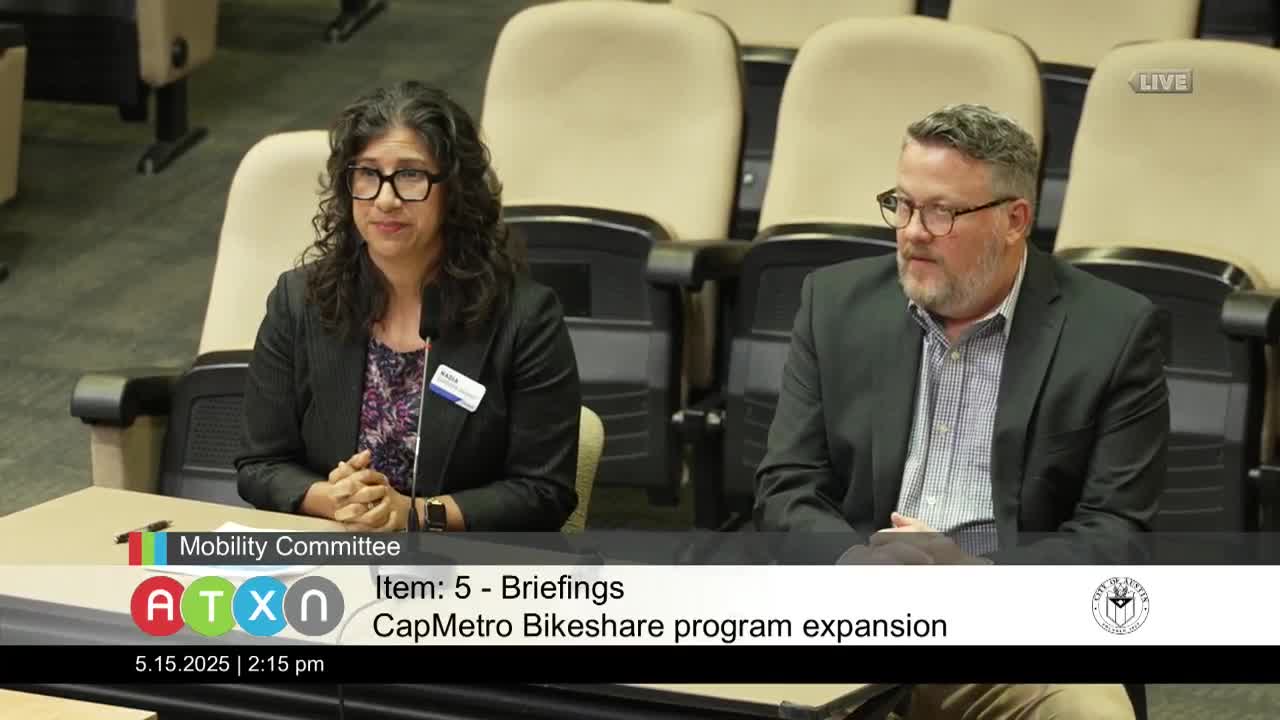Austin Transportation Updates Mobility Projects and Safety Initiatives at Monthly Briefing
May 15, 2025 | Austin, Travis County, Texas
This article was created by AI summarizing key points discussed. AI makes mistakes, so for full details and context, please refer to the video of the full meeting. Please report any errors so we can fix them. Report an error »

During the Austin Mobility Committee meeting on May 15, 2025, discussions centered on enhancing public transportation infrastructure and promoting pedestrian-friendly developments. Council members emphasized the importance of integrating public benefits from developers, particularly in strategic locations along major corridors.
Councilmember Veil highlighted the community's demand for bike-sharing programs, especially in northern areas of the city. He acknowledged operational challenges but stressed the need for gradual expansion to meet residents' needs. "This is considered to be a positive benefit for the folks that live there," he stated, underscoring the practical advantages of improved mobility options.
Councilmember Harper Madison brought attention to innovative developments like the Ivory, a carless community that successfully integrates shared vehicles for residents. She encouraged exploring similar partnerships that promote pedestrian-friendly, multifamily housing, suggesting that such initiatives could inspire future projects.
The meeting also featured updates from the Austin Transportation Public Works Department on ongoing mobility programs. Key highlights included the release of the department's annual report, showcasing significant progress on various projects. Safety was a recurring theme, with over 20 safety projects reported to have reduced crashes by an average of 22%. Notably, some projects achieved crash reductions of up to 70% through improved signal timing.
Upcoming projects include safety upgrades at high-crash intersections and the extension of urban trails, aimed at enhancing connectivity and safety for cyclists and pedestrians. The committee also discussed the Burnet Road segment project, set to begin construction this fall, which will include trail links and transit upgrades.
The meeting concluded with a focus on opportunities for minority and women-owned businesses in upcoming airport construction projects, highlighting a commitment to inclusivity in local development efforts. As the city continues to prioritize mobility and safety, these discussions reflect a proactive approach to addressing community needs and fostering sustainable growth.
Councilmember Veil highlighted the community's demand for bike-sharing programs, especially in northern areas of the city. He acknowledged operational challenges but stressed the need for gradual expansion to meet residents' needs. "This is considered to be a positive benefit for the folks that live there," he stated, underscoring the practical advantages of improved mobility options.
Councilmember Harper Madison brought attention to innovative developments like the Ivory, a carless community that successfully integrates shared vehicles for residents. She encouraged exploring similar partnerships that promote pedestrian-friendly, multifamily housing, suggesting that such initiatives could inspire future projects.
The meeting also featured updates from the Austin Transportation Public Works Department on ongoing mobility programs. Key highlights included the release of the department's annual report, showcasing significant progress on various projects. Safety was a recurring theme, with over 20 safety projects reported to have reduced crashes by an average of 22%. Notably, some projects achieved crash reductions of up to 70% through improved signal timing.
Upcoming projects include safety upgrades at high-crash intersections and the extension of urban trails, aimed at enhancing connectivity and safety for cyclists and pedestrians. The committee also discussed the Burnet Road segment project, set to begin construction this fall, which will include trail links and transit upgrades.
The meeting concluded with a focus on opportunities for minority and women-owned businesses in upcoming airport construction projects, highlighting a commitment to inclusivity in local development efforts. As the city continues to prioritize mobility and safety, these discussions reflect a proactive approach to addressing community needs and fostering sustainable growth.
View full meeting
This article is based on a recent meeting—watch the full video and explore the complete transcript for deeper insights into the discussion.
View full meeting
